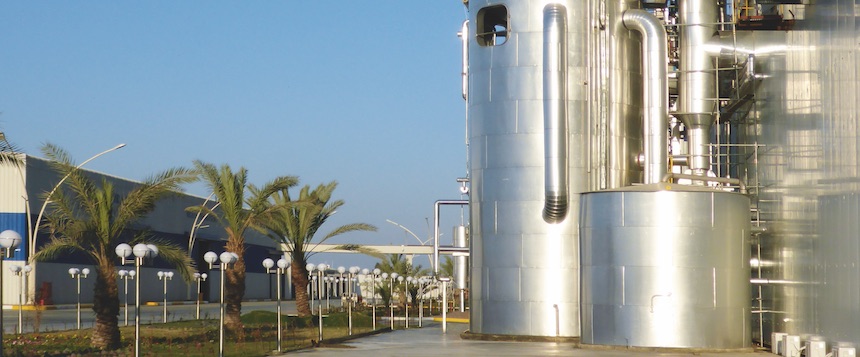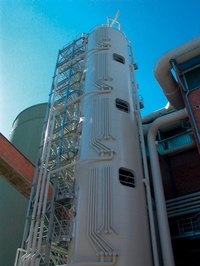The VKT – a highly efficient process solution

01.07.2017
Operating for success
More than 30 years have passed since the first vertical continuous pan (VKT) was commissioned in Germany. Since then, the apparatus has become more and more widely used. Initially in European beet sugar factories; then, in 1995, the first VKT for high-purity products (massecuite purity of about 99.5 percent) was installed in Dubai. In recent years, it has also found its way into cane sugar factories, to increase their efficiency.
There is a reason why the VKT is more and more frequently used today, in beet and cane sugar factories and in refineries. In the 1980s, the advances in measurement and control technology and the increased use of electronics components and automation technology prepared the ground for the automated operation of batch pans (DVK).
Less water, less energy
Sugar house supervisors and plant operators were still needed for their experience. But they had fewer and different tasks, focusing increasingly on monitoring plants and processes. In automated operation, a constant pressure in the vapour chamber could keep supersaturation at a consistent level, which helped to reduce the share of ne crystals. Less water was needed to extract the ne crystals, and less energy for crystallisation.
It only took one more small step to introduce a vertical version, the VKT. Its development made use of the benefits of the DVK: strong agitators ensure continuous circulation of the product and therefore good heat transfer.
In contrast to the DVK, the chambers of the VKT are operated at a lower product level of approx. 400 mm above the top of the calandria. As a result, a far lower heating steam pressure is required. Lowering the heating steam pressure, and therefore water evaporation, is not a problem with lower throughputs. There is no need to add water. When, for instance, the sugar drying station or the centrifugals are not in operation, water evaporation and therefore the massecuite ow can be reduced by lowering the heating steam pressure to zero, without much impact on massecuite circulation.
Why insulation is critical
To reduce heat losses and the formation of ne crystals on the outer shell, a DVK is insulated. Such insulation is even more important for a VKT, to prevent cleaning of the chambers as much as possible. For high-purity solutions, a twin shell was therefore used at critical points (double-cone bottom, area between the lower end of the calandria and the bottom), in addition to the insulation. The VKT would be heated with steam or condensate. This considerably reduced the risk of the massecuite temperature dropping in these areas, and the resulting increased supersaturation and risk of caking. Today, only electrical strip heaters are used in these areas to prevent corrosion inside the twin shell, which can occur when the VKT is not in operation, outside the campaigns.
The control system for the VKT has been continuously improved. With pressure in the vapour chamber at a constant level, for instance, it is now possible to set the dry substance content of the massecuite in every chamber evenly, depending on the setpoint value. Variations in throughput can be handled by adjusting the heating steam pressure. The different control circuits are connected in such a way that this adjustment is almost the only task for the plant operator, in addition to monitoring.
Considerable steam savings, high process consistency
Since the mid-1990s, VKT have become more and more popular in sugar refineries, for high-purity massecuites. The vapour from the first falling- lm evaporator for liquor concentration supplies steam to the VKT at a pressure of well below 1 bar absolute. This results in considerable steam savings and a very high process consistency.
Because of the high purities of R1 massecuite in sugar refineries, the individual chambers have to be cleaned roughly once a week. As each chamber can be bypassed, the VKT can be operated with almost constant throughput during cleaning. In sugar refineries, a VKT can run without interruption all year round.
Given the lower purities at all crystallisation stages in beet and cane sugar factories, the interval between two cleaning phases is much longer. With C-product massecuite, for instance, a VKT needs to be cleaned only every 50 to 60 days. It takes roughly five hours to clean a chamber. During this time, the VKT can continue to run at nominal capacity if the heating steam pressure is adjusted.
Cane sugar factories as electricity producers
In the past few years, the VKT has also gained in importance in cane sugar factories. The aim is to save energy during production, while ensuring continuous operation and a consistent massecuite quality. Another benefit: the additional bagasse can be used to produce electricity, which can be fed into the public grid and sold.
Although a VKT consumes more electricity because of its powerful agitators, these can help achieve a considerably higher crystal content of the massecuite. Less circulation of the run-off in the sugar house substantially lowers the overall energy consumption of a cane sugar factory.
Our projects: new installations, replacements, upgrades
In the past two years, BMA have received orders for new installations, but also for replacements and upgrades. At the Nordzucker factory in Clauen, Germany, we replaced old apparatus with one VKT for C product and another for white sugar.
At Cosumar’s Sidi Bennour beet sugar factory and Casablanca refinery in Morocco, we upgraded the 3-chamber VKT for C-product massecuite and the 4-chamber VKT for R1 massecuite with one chamber each. The aims were to increase capacity and improve the sugar house. In new VKT installations, foundations are always planned to easily permit upgrades with one chamber.
BMA’s order books clearly show that the VKT is becoming more and more popular, also beyond Europe. We expect this development to continue. In the drive towards steam savings, the VKT from BMA is sure to go from strength to strength in cane sugar factories, too.




